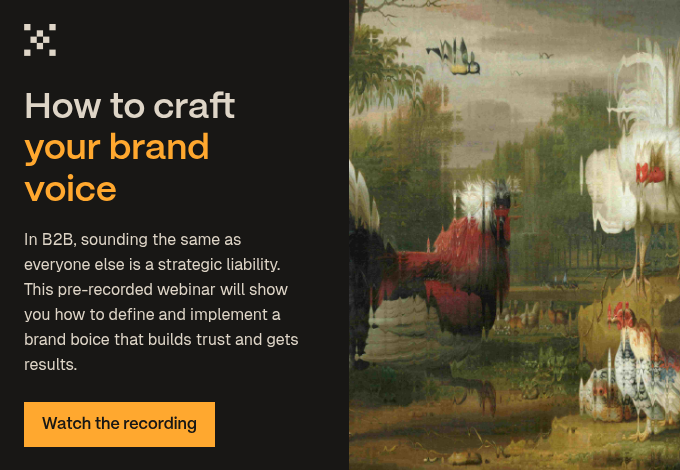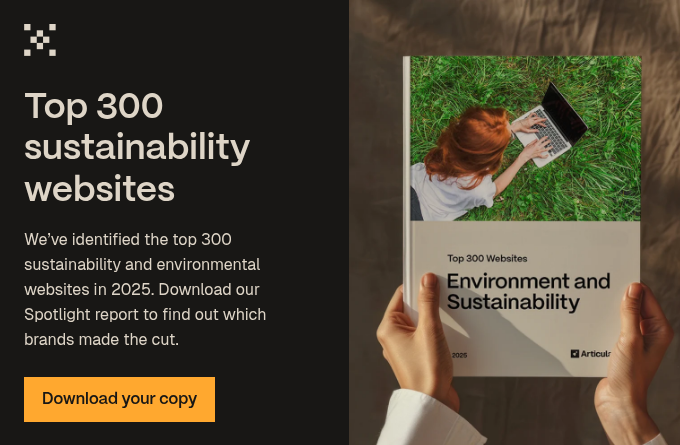If we’re honest with ourselves, cynicism can be fun. It’s indulgent, provocative and subversive. That’s why, if you’ve scrolled through LinkedIn recently, you might have seen some scathing remarks about brand purpose. Some marketers actively argue against it. They assert that marketing doesn’t need to concern itself with purpose, saying it’s a disingenuous ploy.
Of course, the reality is this — having a purpose, sticking to it and using marketing to hold your company to account and promote those values… well, it’s bloody hard work. But if you ask customers, it is worth the effort:
- An Accenture global survey found that 42 percent of customers walk away from a brand as a result of their words or actions on a social issue.
- One in five of those customers never come back.
- In 2018 Unilever found the brands that committed to positive social and environmental change grew 69 percent faster than the rest of their business.
But, purpose-driven branding is tricky to navigate, particularly for B2B brands. There are issues like doom-mongering, authenticity gaps and brand dilution. But, there are also powerful positives that companies can harness if they craft their approach with care.
Let’s explore purpose-driven branding, where it sprang from, and its positives and pitfalls.
What is purpose-driven branding?
Purpose-driven branding demonstrates the reasons your company exists beyond turning a profit. It’s more than becoming a B Corp and putting a badge on your website. It’s the messages you lead with, the initiatives you invest in and the commitments you make to customers, employees and shareholders.
Purpose-driven branding highlights the additional value you offer to conscious customers once you have fulfilled their other buying criteria.
Where did purpose-driven branding come from?
In 2009, Simon Sinek arrived with his Golden Circle and lassoed us all into the bewildering world of brand purpose. But he wasn’t the only reason purpose became a pointed issue for marketers.
B2C and B2B customers are asked to pay increasing premiums for products and services. Then they’re faced with scandals like Apple’s “battery-gate” or Kobe Steel’s data fraud. Events like these have fuelled more cynicism in the markets. Havas’ 2021 Meaningful Brands survey revealed that customers see less than half of brands as trustworthy.
Those same customers also know that brands have the money and influence to make a difference. Nearly three in four customers believe brands must act now for the good of society and the planet. Fifty-three percent of people are also willing to pay more for a brand that takes a stand.
So, how do B2B brands proceed through this murky water? By understanding the mistakes to avoid. After that, they can begin to reap the rewards.
The pitfalls of purpose-driven branding
Pitfall #1: Doom-mongering
Environmental tech companies want to promote climate consciousness. Health tech companies want to advocate for healthy living. Yet, such worthy goals are undermined when you paralyse your audience with too many scary statistics.
With today’s headlines, nobody needs more bad news about the state of the world. In fact, it’s terrible for our health — stressing us out and making us feel more anxious.
Studies have shown that stress and anxiety are not feelings that lend themselves to goal-oriented decision-making. Instead, we default to habits, which isn’t helpful in B2B when you’re trying to convert a new customer. You’re actually making that customer more risk-avoidant and therefore less likely to buy.
You also don’t want to make competitors out to be negligent or nefarious (not least to avoid legal proceedings…) compared to your virtuosity. Talk about throwing stones in glass houses. Consider those people who regularly talk about others’ faults in contrast with their strengths. Do you trust their motives?
Pitfall #2: Authenticity gaps
In 2018, Google replaced the ‘Don’t be evil’ imperative in its code of conduct with ‘Do the right thing’. They didn’t share a reason for the change publicly, but it might have something to do with the ambiguity of ‘evil’.
This ambiguity can create a gap in customer expectations and, therefore, brand authenticity.
You shouldn’t fear trying out different ‘purposes’ to see what fits — it’s part of the purpose-driven branding process. But, you can minimise your authenticity gap if you focus your branding on what you are, what you stand for and what you strive to be vs. what you are not.
The Google case study also stresses the importance of auditing your culture and commitments against claims you make. These could be explicit claims (using terms like ‘sustainable’ or ‘green’). Or implicit claims (the imagery you use to represent your employees and suppliers).
Pitfall #3: Brand dilution
There’s a great deal of emphasis from customers and regulators on the importance of ethics. So we would forgive you for thinking this should be the primary focus of your branding.
In the B2B space, however, it’s important that you don’t obscure the commercial benefits of your products and services. You also want to ensure that you preserve the cultural norms and best practices for branding in your industry. This is so that you still appear credible to your target customers.
Imagine an IT leader tasked with cost reductions, who decides to switch from expensive physical data centres to the cloud. They find two suppliers.
- Supplier X’s branding highlights security, up-time, flexibility and 24-hour service.
- Supplier Y’s branding focuses on carbon-free energy and cooling efficiency.
Which one is more compelling for an IT leader making such a big decision?
Essentially, you have to strike the right tone and the right balance of considerations to persuade your audience.
The positives of purpose-driven branding
Positive #1: Differentiation
Why should a customer buy from you and not a competitor? The answers to this question play an important role in any branding exercise. In terms of purpose-driven branding, you could highlight:
- Sustainability initiatives, like establishing a refurbishment and repair program or switching to more energy-efficient data centres.
- People initiatives, like benefits and training programs that enhance staff well-being, job satisfaction and career opportunities.
- Accountability initiatives, like transparency reports or diversity, equity and inclusion (DEI) programs.
Some of these things might not be unique to your business, or novel in your industry. But, if you’re among the first to communicate these initiatives well, they can still strengthen your offering. There’s also power in being able to back up your initiatives with solid proof points, which will make you stand out and earn your customers’ trust.
Positive #2: Humanisation
Everybody makes mistakes. It’s only human.
Saying that, we now have evidence that, when faced with service failure, customers are more likely to forgive a company if they feel a sense of empathy towards them. This forgiveness is crucial, because researchers have also discovered that it can mitigate the negative effects of service failure. They include negative word-of-mouth and reduced repeat business intentions.
We’ve stressed the importance of maintaining focus on the tangible benefits of your product or service. But, empathy is still a valuable asset when doing business. So, you should always make room for branding elements that emphasise the humanity of your company.
Examples include:
- Sharing real images and short profiles of team members on your company website (ahem, like so.)
- Guidelines that direct internal teams on the tone, frequency and transparency of customer-facing communications.
- Shining a spotlight on your internal experts through thought leadership articles and video content.
- Recognising team members’ contributions by sharing their insightful quotes or congratulating them for certifications or awards on social media (this generates enthusiasm internally, but also showcases your expertise!).
The positive #3: Team motivation
For those of us who aren’t cackling cartoon villains with dollar signs in our eyes, money isn’t the only reason we get out of bed every day. A Gartner survey found that 70 percent of employees say their sense of purpose was defined by work.
Unfortunately, only 15 percent of frontline employees agree that they can live their purpose in their-day-to-day work. This has had a significant impact on attitudes towards work, particularly in light of the COVID-19 pandemic. According to McKinsey, it left two-thirds of US employees questioning their purpose in life, and half of those evaluating their work as a result. This phenomenon resulted in The Great Resignation.
Purpose-driven brands, on the other hand, don’t have the same attrition problems. Deloitte reports that they boast 40 percent higher workforce retention than their competitors.
Your purpose-driven branding curiosity may have been sparked by the potential to grow your customer base. But, the impact on your present and future employees is an equally important consideration.
The future of purpose-driven branding
Whether you agree with the nay-sayers or not, it’s abundantly clear that customers expect more from businesses.
The vast majority of business owners set up with the intention to do right by their customers. But, you’d forgive the general public for thinking otherwise in light of some industries’ profits during the COVID-19 pandemic.
So, companies need to do more to convince customers that they’re in it together. If they don’t, they leave themselves weak against competitors who will.
If you want to future-proof your B2B branding, you need to find and define your purpose, then share it with your audience. Lucky for you, we’re well-practiced in this area. Get your free marketing appraisal right here.

 Posted by
Maddie Saunders
Posted by
Maddie Saunders
.jpg?width=1600&height=800&name=europeana-DfBSs2SSNwQ-unsplash%20(1).jpg)




.jpg?width=400&height=250&name=the-cleveland-museum-of-art-Ncj-lBCuXpo-unsplash%20(1).jpg)
.jpg?width=400&height=250&name=europeana-84R6ipsqaxo-unsplash%20(1).jpg)